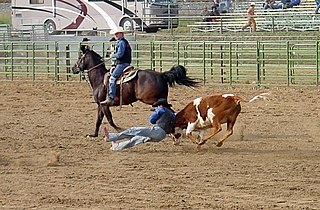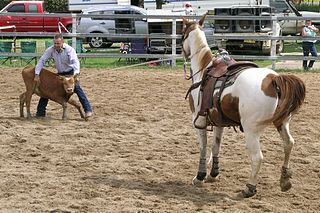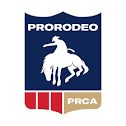
Gymnastics is a type of sport that includes physical exercises requiring balance, strength, flexibility, agility, coordination, and endurance. The movements involved in gymnastics contribute to the development of the arms, legs, shoulders, back, chest, and abdominal muscle groups. Gymnastics evolved from exercises used by the ancient Greeks that included skills for mounting and dismounting a horse, and from circus performance skills.

Equestrianism, commonly known as horse riding or horseback riding, includes the disciplines of riding, driving, and vaulting. This broad description includes the use of horses for practical working purposes, transportation, recreational activities, artistic or cultural exercises, and competitive sport.

Rodeo is a competitive equestrian sport that arose out of the working practices of cattle herding in Spain and Mexico, expanding throughout the Americas and to other nations. It was originally based on the skills required of the working vaqueros and later, cowboys, in what today is the western United States, western Canada, and northern Mexico. Today, it is a sporting event that involves horses and other livestock, designed to test the skill and speed of the cowboys and cowgirls. American-style professional rodeos generally comprise the following events: tie-down roping, team roping, steer wrestling, saddle bronc riding, bareback bronc riding, bull riding and barrel racing. The events are divided into two basic categories: the rough stock events and the timed events. Depending on sanctioning organization and region, other events such as breakaway roping, goat tying, and pole bending may also be a part of some rodeos. The "world's first public cowboy contest" was held on July 4, 1883, in Pecos, Texas, between cattle driver Trav Windham and roper Morg Livingston.

Bull riding is a rodeo sport that involves a rider getting on a bucking bull and attempting to stay mounted while the animal tries to buck off the rider.

Bronc riding, either bareback bronc or saddle bronc competition, is a rodeo event that involves a rodeo participant riding a bucking horse that attempts to throw or buck off the rider. Originally based on the necessary buck breaking skills of a working cowboy, the event is now a highly stylized competition that utilizes horses that often are specially bred for strength, agility, and bucking ability. It is recognized by the main rodeo organizations such as the Professional Rodeo Cowboys Association (PRCA) and the International Professional Rodeo Association (IPRA).

Steer wrestling, also known as bulldogging, is a rodeo event in which a horse-mounted rider chases a steer, drops from the horse to the steer, then wrestles the steer to the ground by grabbing its horns and pulling it off-balance so that it falls to the ground. The event carries a high risk of injury to the cowboy. Some concerns from the animal-rights community express that the competition may include practices that constitute cruelty to animals, but the injury rate to animals is less than 0.05%. A later PRCA survey of 60,971 animal performances at 198 rodeo performances and 73 sections of "slack" indicated 27 animals were injured, again around 0.05%.

Team roping also known as heading and heeling is a rodeo event that features a steer and two mounted riders. The first roper is referred to as the "header", the person who ropes the front of the steer, usually around the horns, but it is also legal for the rope to go around the neck, or go around one horn and the nose resulting in what they call a "half head". Once the steer is caught by one of the three legal head catches, the header must dally and use his horse to turn the steer to the left.

Calf roping, also known as tie-down roping, is a rodeo event that features a calf and a rider mounted on a horse. The goal of this timed event is for the rider to catch the calf by throwing a loop of rope from a lariat around its neck, dismount from the horse, run to the calf, and restrain it by tying three legs together, in as short a time as possible. A variant on the sport, with fewer animal welfare controversies, is breakaway roping, where the calf is roped, but not tied.

Steer roping, also known as steer tripping or steer jerking, is a rodeo event that features a steer and one mounted cowboy.

Barrel racing is a rodeo event in which a horse and rider attempt to run a cloverleaf pattern around preset barrels in the fastest time. In collegiate and professional ranks, it is usually a women's event, though both sexes compete at amateur and youth levels. It requires a combination of the horse's athletic ability and the horsemanship skills of a rider in order to safely and successfully maneuver the horse around three barrels placed in a triangle pattern within a large arena.

Breakaway roping is a variation of calf roping where a calf is roped, but not thrown and tied. It is a rodeo event that features a calf and one mounted rider. The calves are moved one at a time through narrow runs leading to a chute with spring-loaded doors. The horse and rider wait in a box next to the chute that has a spring-loaded rope, known as the barrier, stretched in front. A light rope is fastened from the chute to the calf's neck, releasing once the calf is well away from the chute and releasing the barrier, which is used to ensure that the calf gets a head start. Once the barrier has released, the horse runs out of the box while the roper attempts to throw a lasso around the neck of the calf.

Charrería is a sport and discipline arising from equestrian activities and livestock traditions used in the haciendas of old Mexico.
The National Finals Rodeo (NFR) is the premier rodeo event by the Professional Rodeo Cowboys Association (PRCA). The NFR showcases the talents of the PRCA's top 15 money-winners in the season for each event.

The Professional Rodeo Cowboys Association (PRCA) is the largest rodeo organization in the world. It sanctions events in the United States, Canada, and Mexico, with members from said countries, as well as others. Its championship event is the National Finals Rodeo (NFR). The PRCA is headquartered in Colorado Springs, Colorado, United States.

Gymkhana is an equestrian event consisting of speed pattern racing and timed games for riders on horses. These events often emphasize children's participation and may be organized by a recognized Pony Club or a 4-H club. In parts of the western United States, this type of competition is usually called an "O-Mok-See" competition, a term derived from a Native American phrase said to mean "games on horseback". Very small events with little or no prize money, designed for beginners or riders at a local level, are sometimes called playdays. "Gymkhana" is the word used in most of the rest of the English-speaking world, including the United Kingdom and both the East Coast and the West Coast of the United States.
Chute dogging is a rodeo event related to steer wrestling, in which the steer used weighs between 400 and 500 pounds. However, the competitor starts the event in a roping chute with the steer as opposed to grabbing onto the steer from horseback. The event is designed to give novices a chance to prepare for steer wrestling.

A lead, lead line, lead rope (US) or head collar rope (UK), is used to lead an animal such as a horse. Usually, it is attached to a halter. The lead may be integral to the halter or, more often, separate. When separate, it is attached to the halter with a heavy clip or snap so that it can be added or removed as needed. A related term, lead shank or lead chain refers to a lead line with a chain attached that is used in a variety of ways to safely control possibly difficult or dangerous horses if they will not respond to a regular lead.
The Heart of the North Rodeo is located in Spooner, Wisconsin. The Rodeo takes place the first full weekend in July every year since 1954, except 2020. Spooner Rodeo fans will always see a different act every night, as each rodeo is never the same. Fans from all over come to watch the professional cowboys and cowgirls compete in the 7 main events of rodeo, and even some up and coming little cowboys and cowgirls.
Fred Whitfield is an American former professional rodeo cowboy who specialized in tie-down roping. He won eight Professional Rodeo Cowboys Association (PRCA) world championships and three National Finals Rodeo (NFR) aggregate titles. Seven of those titles were World Tie-Down Roping Championships and one was the World All-Around Cowboy Championship. He is one of a very few black professional cowboys and by far the most successful. Whitfield was elected to the ProRodeo Hall of Fame in 2004.
The National Finals Steer Roping (NFSR), organized by the Professional Rodeo Cowboys Association (PRCA), is the premier championship steer roping event in the United States. It showcases the talents of the PRCA's top 15 money-winners in the steer roping world standings at the end of the regular season as they compete for the world title.



















